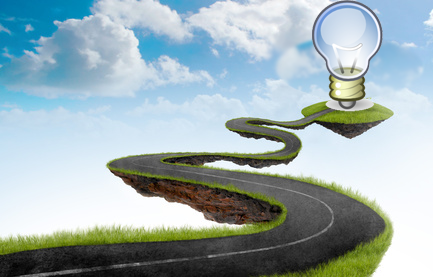Clearing Your Creative Pathways
Posted on April 24, 2013 by Tom Evans
 Authors, artists and musicians all follow a creative path.
Authors, artists and musicians all follow a creative path.
And so do those who decide to apply the creative process to other aspects of life.
Some paths meander gracefully downhill; some paths are strewn with debris and the going might get tough; some paths go up steep and dangerous rock faces. We have free will to help us choose which Creative Path we want to explore — and the experience we want to have on it.
When creativity comes our way too, we can make its passage easy or we can prevaricate and procrastinate. It’s amazing how creative we can be at doing everything else but what we most want to do.
When researching my book on how to allow creative sparks to arrive and give them smooth passage, I could find no real evidence as to how we receive and experience light bulb moments on request. What I did was meditate, go into that quiet space and allowed what I think of as “universal wisdom” to guide me.
What came amazed and astounded even me. It came in as a full vision, in a split second, and it seemed — and still seems to me — to make absolute intuitive sense. I did not “make it up” in the conventional sense. It arrived as a perfect example of the process it describes.
The whole sequence described here takes less than a second. This is because when lightbulbs flash, the recipient has momentarily stepped out of space and time.
- Light bulb moments arrive in the still point between the in and the out breath. They come in either via the crown or the back of the skull, the cerebellum. If you are attuned to seeing the aura, you can pick up their flashes.
- The inspiration is routed right down the spinal column to the root mind. From there, we check in with the Earth Mind for its ecology and appropriateness for all life forms.
- If OK, it passes back up to the gut mind and our intuitive centre where we check if it is safe and right for us and appropriate at this point in time.
- If it passes muster, it goes to the heart mind and we either fall in love with the idea, or reject it.
- It then is passed to the right brain which then consciously “sees” the whole of the vision. The left brain gets in on the act and fills in some of the detail. It is only at this point we become consciously aware of any detail of the light bulb moment.
- For particularly striking inspirations, the throat mind then gets involved and shouts something, like “Eureka”, or gasps, or sings out loud.
I have nothing but empirical evidence that this is what happens but all my mind centres, as described above, assent to this version of events.
What becomes clear in this sequence is that inspirations are whole body and whole mind events. We feel them in our water, our bones and our soul. They can wake us up in the early hours.
It’s clear too that if we are ungrounded, fearful or not in love with ourselves or our work, the lower mind centres block the flow.
If our monkey mind is over-active or we chat incessantly, this will stop the ideas coming along in the first place or dissipate them when they do.
For twenty four hours of each day, we are awash with light bulb moments, serendipities and signs. Not all of them reach our conscious awareness. We can decide which we tune into, and which are right for us on our particular creative path.
What do you think? Do you agree with this assessment of allowing inspiration? How is it for you? Let us know in the comment box below.
Tom Evans has written 6 non-fiction books on consciousness, creativity and the nature of thought. He is a specialist at clearing writer’s and author’s blocks (they are different). He is also the creator of Bending Time, an interactive and immersive ecourse that shows how you can get into the zone and get more done in less time.













Be the first to leave a comment